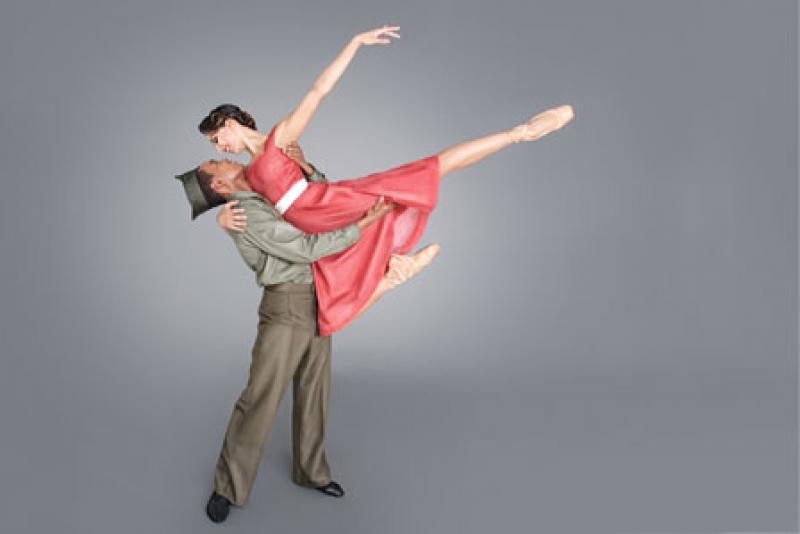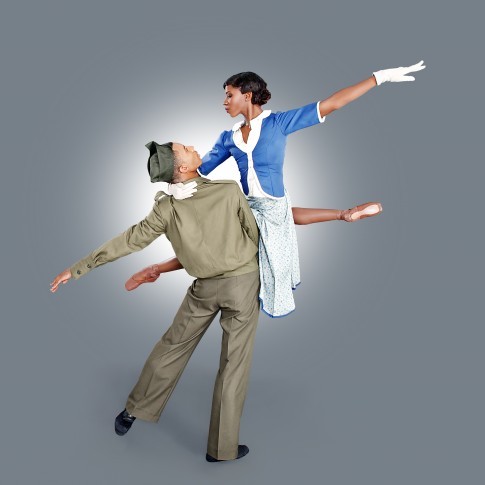Ballet Black, Linbury Studio Theatre, Royal Opera House | reviews, news & interviews
Ballet Black, Linbury Studio Theatre, Royal Opera House
Ballet Black, Linbury Studio Theatre, Royal Opera House
A quad bill more promising on paper than in today's austere actuality

Ballet Black open their eighth Linbury Studio Theatre season with a quadruple bill of new works which looks promising on paper but less so in actuality. The evening begins with Robert Binet’s EGAL, the title being a (now obsolete) Middle English word meaning equal, which Binet used as the piece’s crux.
For starters, the pairing of the dancers seemed unequal from the get-go – with Cira Robinson’s forthright presence making Jacob Wye’s unsureness even more apparent. The movement denotes an uncomfortable/uncoordinated feel (perhaps the aforementioned complications being aired?), and isn’t helped by the hard on the ear score either (GODOT by Volker Bertelmann and Hilary Hahn).
Considering Javier de Frutos’s notorious past, the piece feels very PC
There is a moment where both dancers perform a movement phrase in unison which allows them to travel and show a sense of fluidity unseen until then, as well as demonstrate the beginnings of an arm movement language that uses scythe-like sweeps to attract the eye. Binet is also guilty of one of my pet peeves – the "running around the stage for no apparent reason" trait – which always feels like a colossal waste of the audience's time and the dancers' energy.
Ludovic Ondiviela’s Dopamine (you make my levels go silly) - a duet - is based around the neurochemical process humans experience when feeling bliss. Ondiviela translates this into a pas de deux of a romantic exploration of young love progressing into recognised comfort – which features some fine lifts but nothing groundbreaking - that moves into a second motif of a gestural arm idiom executed at great speed and for what feels like an eternity. Neither exploration necessarily broadened my take on bliss.
The work also features a new score, Perpetuum by Fabio D’Andrea, and Ondiviela uses the relentless rhythm and sweeping melodies well. But though the two dancers (Sayaka Ichikawa and Jazmon Voss) did the movement justice, their emotional connection didn’t translate beyond the proscenium.
 Closing the first part is Javier de Frutos’s The One Played Twice, a work for four dancers using a Hawaiian-themed collection of music in Barbershop style. Considering de Frutos’s notorious past, the piece feels very PC, to the point that it doesn’t really feel like one of his. The four dancers switch between solos, duets, trios and foursomes, which have an initial abstract feel before latching onto an emotional underpinning, based upon relationships and longing. Each musical section is followed by dance in silence – which feels a bit clunky, but at least allows for a short respite from the barbershop fest.
Closing the first part is Javier de Frutos’s The One Played Twice, a work for four dancers using a Hawaiian-themed collection of music in Barbershop style. Considering de Frutos’s notorious past, the piece feels very PC, to the point that it doesn’t really feel like one of his. The four dancers switch between solos, duets, trios and foursomes, which have an initial abstract feel before latching onto an emotional underpinning, based upon relationships and longing. Each musical section is followed by dance in silence – which feels a bit clunky, but at least allows for a short respite from the barbershop fest.
The second half is devoted to Christopher Marney’s War Letters (pictured above right) – a piece using literature ranging from private letters to poetry in order to muse on war and its fallout. The work is split into five sections, four morbid, one joyous; and Marney does well to fit so much into such a short timeframe.
The fourth movement – The Heavy Coat – is the most original, seeing Marney use a coat as a metaphor (and prop) for love and the weighted obligations that come with it. Overall though the piece is a bit school-ish, and Marney’s movement language flits in a lacklustre melange of pseudo-neo-classical form and straightforward ballet-class steps. Likewise with the musical choices – hackneyed Shostakovich and (the overtly obvious) Glenn Miller.
In the current art chasm all new works should be savoured, but economic pressure also highlights the value of everything. I was impressed by the dancers and David Plater’s lighting designs - yet largely deflated by the choreography.
rating
Explore topics
Share this article
Add comment
The future of Arts Journalism
You can stop theartsdesk.com closing!
We urgently need financing to survive. Our fundraising drive has thus far raised £49,000 but we need to reach £100,000 or we will be forced to close. Please contribute here: https://gofund.me/c3f6033d
And if you can forward this information to anyone who might assist, we’d be grateful.

Subscribe to theartsdesk.com
Thank you for continuing to read our work on theartsdesk.com. For unlimited access to every article in its entirety, including our archive of more than 15,000 pieces, we're asking for £5 per month or £40 per year. We feel it's a very good deal, and hope you do too.
To take a subscription now simply click here.
And if you're looking for that extra gift for a friend or family member, why not treat them to a theartsdesk.com gift subscription?
more Dance
 'We are bowled over!' Thank you for your messages of love and support
Much-appreciated words of commendation from readers and the cultural community
'We are bowled over!' Thank you for your messages of love and support
Much-appreciated words of commendation from readers and the cultural community
 R:Evolution, English National Ballet, Sadler's Wells review - a vibrant survey of ballet in four acts
ENB set the bar high with this mixed bill, but they meet its challenges thrillingly
R:Evolution, English National Ballet, Sadler's Wells review - a vibrant survey of ballet in four acts
ENB set the bar high with this mixed bill, but they meet its challenges thrillingly
 Like Water for Chocolate, Royal Ballet review - splendid dancing and sets, but there's too much plot
Christopher Wheeldon's version looks great but is too muddling to connect with fully
Like Water for Chocolate, Royal Ballet review - splendid dancing and sets, but there's too much plot
Christopher Wheeldon's version looks great but is too muddling to connect with fully
 iD-Reloaded, Cirque Éloize, Marlowe Theatre, Canterbury review - attitude, energy and invention
A riotous blend of urban dance music, hip hop and contemporary circus
iD-Reloaded, Cirque Éloize, Marlowe Theatre, Canterbury review - attitude, energy and invention
A riotous blend of urban dance music, hip hop and contemporary circus
 How to be a Dancer in 72,000 Easy Lessons, Teaċ Daṁsa review - a riveting account of a life in dance
Michael Keegan-Dolan's unique hybrid of physical theatre and comic monologue
How to be a Dancer in 72,000 Easy Lessons, Teaċ Daṁsa review - a riveting account of a life in dance
Michael Keegan-Dolan's unique hybrid of physical theatre and comic monologue
 A Single Man, Linbury Theatre review - an anatomy of melancholy, with breaks in the clouds
Ed Watson and Jonathan Goddard are extraordinary in Jonathan Watkins' dance theatre adaptation of Isherwood's novel
A Single Man, Linbury Theatre review - an anatomy of melancholy, with breaks in the clouds
Ed Watson and Jonathan Goddard are extraordinary in Jonathan Watkins' dance theatre adaptation of Isherwood's novel
 Peaky Blinders: The Redemption of Thomas Shelby, Rambert, Sadler's Wells review - exciting dancing, if you can see it
Six TV series reduced to 100 minutes' dance time doesn't quite compute
Peaky Blinders: The Redemption of Thomas Shelby, Rambert, Sadler's Wells review - exciting dancing, if you can see it
Six TV series reduced to 100 minutes' dance time doesn't quite compute
 Giselle, National Ballet of Japan review - return of a classic, refreshed and impeccably danced
First visit by Miyako Yoshida's company leaves you wanting more
Giselle, National Ballet of Japan review - return of a classic, refreshed and impeccably danced
First visit by Miyako Yoshida's company leaves you wanting more
 Quadrophenia, Sadler's Wells review - missed opportunity to give new stage life to a Who classic
The brilliant cast need a tighter score and a stronger narrative
Quadrophenia, Sadler's Wells review - missed opportunity to give new stage life to a Who classic
The brilliant cast need a tighter score and a stronger narrative
 The Midnight Bell, Sadler's Wells review - a first reprise for one of Matthew Bourne's most compelling shows to date
The after-hours lives of the sad and lonely are drawn with compassion, originality and skill
The Midnight Bell, Sadler's Wells review - a first reprise for one of Matthew Bourne's most compelling shows to date
The after-hours lives of the sad and lonely are drawn with compassion, originality and skill
 Ballet to Broadway: Wheeldon Works, Royal Ballet review - the impressive range and reach of Christopher Wheeldon's craft
The title says it: as dancemaker, as creative magnet, the man clearly works his socks off
Ballet to Broadway: Wheeldon Works, Royal Ballet review - the impressive range and reach of Christopher Wheeldon's craft
The title says it: as dancemaker, as creative magnet, the man clearly works his socks off
 The Forsythe Programme, English National Ballet review - brains, beauty and bravura
Once again the veteran choreographer and maverick William Forsythe raises ENB's game
The Forsythe Programme, English National Ballet review - brains, beauty and bravura
Once again the veteran choreographer and maverick William Forsythe raises ENB's game

Comments
Seems each year there is at
Did you really attend the